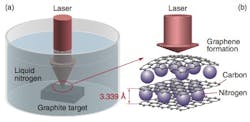Iranian researchers using lasers to produce graphene
Tehran, Iran -- Researchers in Iran say they have devised a method to produce graphene by laser ablation in cold liquid media, a process that promises simpler and more effective control of the finished product.
The research, a collaboration between Tehran's Amirkabir University of Technology and Imam Khomeini International University in Qazvin, Iran, uses a pulsed nanosecond Nd:YAG laser (Nd:Y3Al5O12) in liquid nitrogen to conduct fast, controlled single-stage synthesis of graphene with high yields. The process eliminates the need for vacuum equipment, high-temperature furnaces, or long processing periods typically seen in conventional graphene fabrication methods: chemical vapor deposition (CVD), heat treatment of carbon-containing substrates, liquid phase exfoliation, unzipping of nanotubes, or chemical/electrochemical reduction of exfoliated graphite oxide.
Their technique is better suited for volume production, they say, due to the fast flow circulation of liquid nitrogen. (Liquid argon or helium can be substituted for the liquid nitrogen, they say, which opens up different laser irradiation parameters such as beam energy, pulse repetition and width, and wavelength.) The quality of graphene sheets could be improved by using a highly ordered pyrolytic graphite (HOPG) target with high-temperature gradient due to liquid helium (-268.93°C) at optimum laser fluencies.
Below is a snippet from the paper, which is published in Laser Physics Letters, vol.9, issue 7, pp 547-552 (and apparently was published online in May of this year):
Graphene is fabricated by the pulsed nanosecond laser ablation in liquid nitrogen (-195.79°C) using a Q-switched Nd:YAG laser at 1064 nm. Laser ablation and the subsequent plasma formation is known as a threshold dependent event. Above threshold, several laser irradiation conditions were examined and according to the graphene quality, the suitable one was chosen with 10 ns duration, 5 Hz repetition rate, 60 mJ pulsed energy, and 6 J/cm2 energy density. The exposure time was set to be 20 min equivalent to 6000 shots. At first the graphite target with 5 mm thick and 5 cm diameter was placed in the irradiation cell having BK7 window in front of the laser beam. The cell was filled with liquid nitrogen as the media for laser ablation. The injection of liquid nitrogen into cell continually goes on as long as a thermal steady state condition is achieved. The beam was focused through a concave lens to nearly one mm2 spot size at graphite target. After laser exposure, the residual liquid has evaporated at the room temperature. Subsequently, deionized (DI) water was added to the cell establishing a suspension for the carbon sheets collection. The graphite is immersed in the cryogenic liquid such that the latter as a mono-layer 2D-fluid uniformly diffuses into the interlayer spacing. Regarding the molecular nitrogen size and the layer spacing of graphite (3.339Å),the liquid likely penetrates into the interlayer spacing, where the molecules expand to gaseous phase during laser exposure.
About the Author

James Montgomery
Associate Editor
James manages editorial production for news (online and print) and newsletters, as well as the magazines' new product sections. Jim has 13 years’ experience in producing Web sites and e-mail newsletters in various technology markets for CNet, ZDNet, Digital City Boston/AOL, and KM World.

